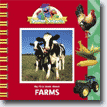 
|
In My First Book About Farms , Grover (who initially indicates he prefers to be called Farmer Grover) and Elmo are having a snack and discussing the origin of different types of foods. Specifically, they focus on how a farm operates and how food is grown and processed. , Grover (who initially indicates he prefers to be called Farmer Grover) and Elmo are having a snack and discussing the origin of different types of foods. Specifically, they focus on how a farm operates and how food is grown and processed.
Farmer Grover explains that some foods like apples and corn grow on a farm in their natural state, while others, such as wheat, have to go through a process to become the bread you might grab as a snack. The books also talks about farm machinery (including a tractor, baler, and swather), and each piece of equipment is beautifully photographed to provide the greatest amount of detail. There is also discussion about the variety of animals that can be found on the farm, from the hens laying eggs to the dogs that might help move other groups of animals.
The book covers a lot of information that will likely appeal to children of a wide range of ages. The problem is that this presentation is a positive attribute just as much as it is a negative one. On one hand, it is appealing to have a book that children will likely enjoy as they grow.
In their earlier years, for example, readers will likely follow Farmer Groverís instructions to practice mooing like a cow, while learning about the purpose of silos and why barns are red will become more interesting as they mature. Along these same lines, the text (which is much more plentiful than the Sesame Street books outside of the series) may be appealing to older readers but may be so advanced that is turns off the youngest readers - even though there is plenty of other age appropriate information through the book.
My First Book About Farms has the vibrant Sesame Street characters, bright illustrations, and professional photographs that enhance its appeal. The challenge will be to find an audience that is not turned off by the components of the book that are too basic or too challenging, depending upon when they come across this selection. has the vibrant Sesame Street characters, bright illustrations, and professional photographs that enhance its appeal. The challenge will be to find an audience that is not turned off by the components of the book that are too basic or too challenging, depending upon when they come across this selection.
|







|